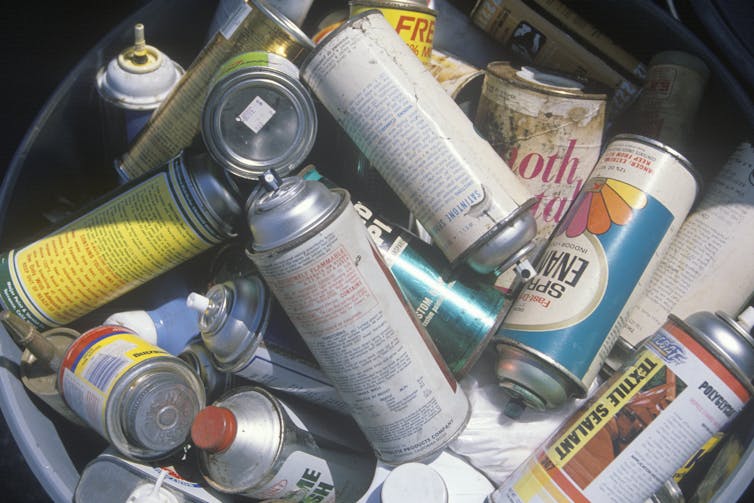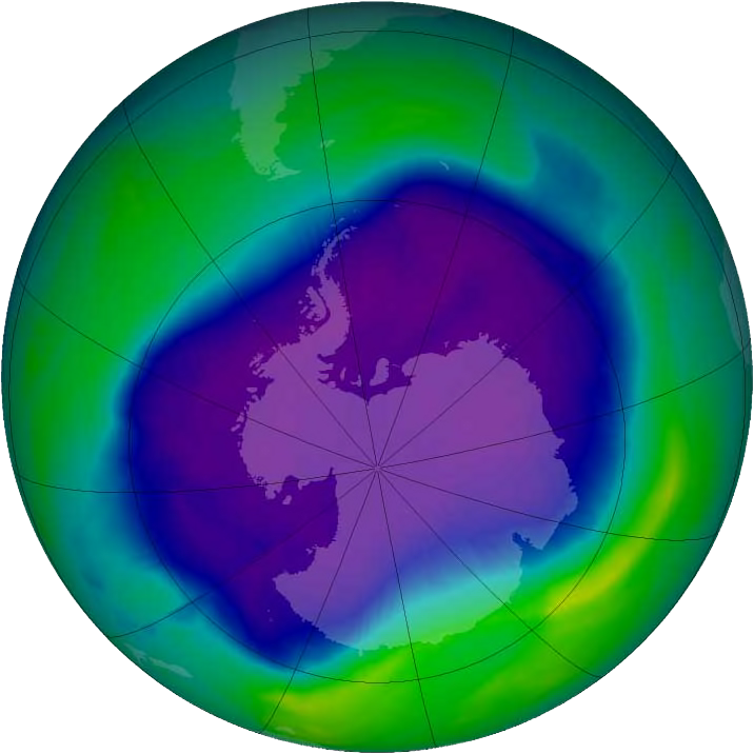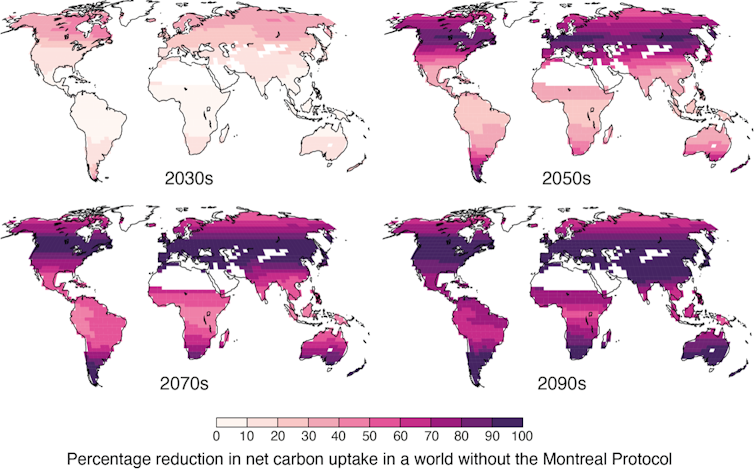Can We Repair The Ozone Layer
Spring 2060. In dark glasses, a broad sunhat and with what little exposed peel left caked in sun foam, a child stares at the woodland beyond from their house. Information technology looks scraggly and stunted, and with far fewer leaves than in the onetime photos she has seen. Still, no time to dwell on it: there'south a UV index of 20 and she's already spent five minutes outside.
Thankfully, this is not our time to come. Due to steps the globe took in the 1980s to protect the ozone layer, a region of the upper temper that absorbs the Dominicus'southward harmful ultraviolet (UV) radiations, we have ane less environmental problem to worry about.
In the mid-1970s, scientists realised that the ozone layer was being depleted by the growing use of chlorofluorocarbons (CFCs) as refrigerants and every bit propellants in aerosol cans, amid other applications. With the 1987 signing of the Montreal Protocol, which was subsequently strengthened past numerous amendments and ratified by 197 countries, the world phased out CFCs. Today, Chlorofluorocarbon levels in the temper are falling and the ozone layer is beginning to recover.

But what if the Montreal Protocol was never signed? What would the earth we managed to avoid have looked similar? This is the subject area of a new study led by me with an international team of collaborators.
In before research, scientists showed there would have been thousands more skin cancer cases in such a earth, where the ozone layer is thinner and higher levels of UV radiations achieve the planet'southward surface. There would as well have been additional climate warming, since CFCs, like carbon dioxide (CO₂), are too greenhouse gases, although far more than stiff. Our focus was on what could have happened to vegetation.
Like humans, plants are damaged when exposed to loftier UV levels. Plants blot CO₂ every bit they grow, simply when UV radiation increases by x%, plants accrue 3% less biomass. Without the Montreal Protocol, nosotros estimated that UV levels would have been 4.5 times higher on average globally than today at the cease of the century. Nosotros also estimated that by 2050, European, Asian and Northward American UV levels would be higher than they are in the present-mean solar day torrid zone.
Overall, this means that more of the CO₂ humans emit would have remained in the atmosphere, rather than being locked up in plants and the soil. And this actress CO₂ would accept led to more global warming.
A world without the Montreal Protocol
Using computer models to represent the climate, the temper's chemical science, vegetation and the carbon cycle, we simulated two worlds. The get-go assumed that the 1974 paper alerting the globe to the dangers of CFCs was never published and their use grows at three% a yr. The second is a world where CFCs are controlled and the ozone layer recovers, the world we live in at present and are on runway to inhabit.
Apart from the CFCs, the two simulated worlds are identical. In both, CO₂ and other greenhouse gas emissions follow an intermediate scenario for the 21st century, which is one of several used to inform the United nations'south Intergovernmental Panel on Climate Change reports.
The world in which CFCs were phased out looks like what nosotros would expect from warmer time to come climates. Global temperatures increase, with all their negative consequences, but – equally nosotros expect for the real world – the ozone layer recovers to its historic levels by the middle of the century. In the other world, the ozone layer drastically thins and by the end of the century ozone concentrations everywhere autumn below levels seen in the Antarctic ozone pigsty.

By the 2050s, because of UV harm, plants in the world where Chlorofluorocarbon use continues unabated absorb half the carbon they exercise in the earth where CFCs were phased out. By the end of the century, plants in this loftier-Cfc earth absorb less than fifteen% of the carbon they do in the other world, resulting in 30% less carbon stored in plants and soils. This means 30% more CO₂ in the atmosphere by the end of the century, which adds 0.8°C more warming to the climate.
By itself, this 0.eight°C would be enough to take current global temperatures (but over 1°C above the pre-industrial boilerplate) to beyond the one.5°C level that represents the most ambitious target of the Paris Understanding. Adding the 1.7°C that would have resulted from the greenhouse effect of CFCs themselves means that an extra 2.5°C of warming was prevented by the Montreal Protocol.

While nosotros take avoided the globe from our simulations, threats to the ozone layer still exist. Some scientists favour counteracting climatic change by emulating the global cooling effects of large volcanic eruptions – injecting particles into the upper atmosphere in a process known every bit stratospheric sulphate geoengineering.
Merely this could deplete the ozone layer. Our study shows that the knock-on effect on the biosphere must be considered in whatever affect assessment of such actions.
For its effectiveness in acting on dire scientific warnings, it'southward tempting to recall of the Montreal Protocol every bit a model for climate negotiations. Yet with simply a scattering of companies making CFCs and alternative chemicals readily available, the ozone issue was far more than straightforward than reducing emissions from fossil fuels.
Baca juga: Shrinking hole in the ozone layer shows what collective action tin can reach
Withal, equally well as protecting the ozone layer, the Montreal Protocol has itself been a phenomenally successful climate treaty. It has controlled non merely the emissions of highly potent greenhouse gases like CFCs, but, as we have shown, information technology has avoided boosted CO₂ levels through protecting the world's found life.
Can We Repair The Ozone Layer,
Source: https://theconversation.com/repairing-ozone-layer-is-also-reducing-co-in-the-atmosphere-new-study-166216
Posted by: woodsidetowery.blogspot.com


0 Response to "Can We Repair The Ozone Layer"
Post a Comment